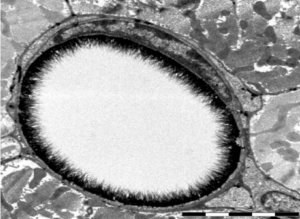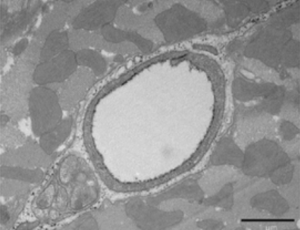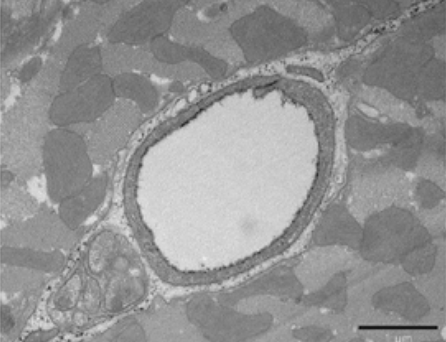Please read: THE ENDOTHELIAL GLYCOCALYX- PART I before this blog. In it, you hopefully learned of the critical importance of the endothelial glycocalyx (EGC), which plays the major critical role in maintaining the health of the endothelium (lining of all blood vessels), thereby protecting it from damage that leads to arteriosclerosis and plaque buildup, as the major cause of cardiovascular disease and ischemic stroke (lack of blood from blood vessel blockage). Blood vessel damage also leads to loss of blood vessel elasticity, leading to high blood pressure (hypertension).
You also learned that the EGC is a very thin gel-like cover over the endothelial cells lining the blood vessels, that looks like hair (cilia) or a lawn. Damage to the EGC is the initial step that eventually can lead to arteriosclerosis. It is the EGC that allows for maintaining “tone” of the vessels, and therefore blood pressure. This is largely accomplished by the enzyme endothelial nitric oxide synthase, located in the EGC. eNOS produces NO locally, which prevents adhesion of white blood cells and platelets to the endothelium, a necessary step in initiating damage to the vessels. eNOS will be further discussed in a blog to follow.
I noted that supplements including N-Acetyl Cysteine (NAC), which promotes production of the potent anti-oxidant glutathione; and Vitamin K2, can be helpful in restoring the EGC. Other natural products (Nutriceuticals) may also be of help, including two types of marine algae (called Monostroma Latissium and Monostroma Nitidum). The remainder of this blog will discuss a product called Arterosil, which contains these algae as well as 3 plant products acting in synergy to assist in restoration. Research articles and references discussed in this blog are located at: https://calroy.com/committed-to-research/ . Relevant studies regarding Arterosil and regression of carotid artery plaque and plaque reduction, glycocalyx regeneration, white blood cell adhesion, high blood pressure, and neuropathy are cited, and the highlights discussed below:
- Carotid artery MRI’s taken before and after 60-days of Arterosil treatment showed plaque regression of 63% in women, and 47% in men
- 4-11 months of Arterosil showed a 52% average reduction of plaque in 10 patients. 7 people showed reduction >52%, 3 showed an increase, but in all cases, at the end, all calcific plaque (more dangerous) disappeared
- An in vitro study used glucose to damage the glycocalyx. Arterosil prevented damage to the EGC and assisted in repair
- Another in vitro experiment in mice showed that damaging the EGC led to significant increase in adhesion of white blood cells to the underlying endothelium
- 19 subjects had their arterial elasticity tested with a pulse-wave analyses. After taking only one Arterosil, the elasticity increased by 90% on average 20 hours after swallowing the capsule
- 10 people with high blood pressure were given one Arterosil twice daily for 3 months. A significant decrease in diastolic blood pressure from 93 to 82 occurred after 3 months
- 20 diabetic patients with peripheral neuropathy showed a decreased neuropathy score of 11% after 3 months of Arterosil
The major active ingredient in the algae extract is Rhamnan sulfate, which is what helps increase arterial elasticity and reduces plaque formation, while reducing the dangerous type of necrotic plaque and increasing vessel lumen (interior of the vessel) size. It promotes resorption of plaque, rather than causing it to break off, where it could lodge in another vessel leading to an ischemic stroke.
According to Mark Houston, MD, professor, author, and Director of St. Thomas Hospital Hypertension Institute, “Rhamnan sulfate changes the morphology of plaques, making them more stable. These are very significant changes. Nothing else does this. No drug can do this. Statins reduce lipid rich necrotic plaques by about 25%, which is meaningful, but not even close to what you can get with Rhamnan sulfate”. (Note: another study using Rhamnan sulfate for 2 months led to an average 64% regression of lipid-rich necrotic plaque).
Given the recent Covid epidemic (and ongoing cases), the EGC is of considerable interest. Early in the pandemic, it was shown that patients with severe Covid had marked degradation of the EGC, leading to severe blood vessel damage, blood clots, decreased eNOS, and platelet adhesion. The EGC binds the viral spike protein. It is well known that Covid interacts with what is called the ACE2 receptor, found on cell surfaces to gain entry into the cells. The EGC protects the cell surfaces from exposure of the ACE2 receptor to Covid, reducing risk of infection. Thus susceptibility of infection may be dependent upon status of the EGC.


Normal Endothelial Glycocalyx Damaged Endothelial GLycocalyx
If you have any of the known risk factors discussed in this and Part I, it would be wise to consider making lifestyle changes to improve diet and exercise, and supplementing with Arterosil, anti-oxidants and select polyphenols. There is a second, critical component to promoting vascular health, and that is nitric oxide mentioned above and in Part I. Part III of this Endothelium-related blog will thoroughly discuss nitric oxide.
About the Author: Dr. Douglas L. Weed
Dr. Weed practices Functional Nutrition, Chiropractic care, and offers weight loss solutions in Napa, CA at Heun Chiropractic, Inc. He has a doctorate in Chiropractic care and he has received certifications in physical rehabilitation and as a Qualified Medical Examiner. With a post-graduate certification in Functional Medicine, focusing on functional endocrinology, digestive disorders and Peripheral Neuropathy, he is committed to lifelong education and helping patience transform their health.

